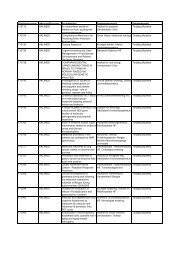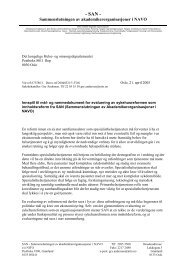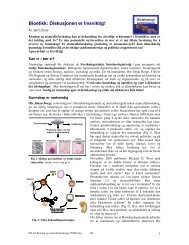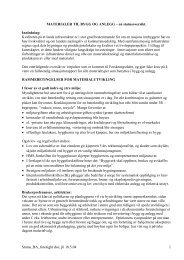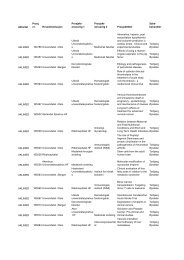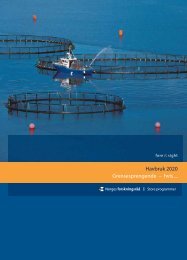A Revolution in R&D
A Revolution in R&D
A Revolution in R&D
Create successful ePaper yourself
Turn your PDF publications into a flip-book with our unique Google optimized e-Paper software.
14<br />
and generally help<strong>in</strong>g to optimize screen<strong>in</strong>g. The<br />
power of this approach is expected to <strong>in</strong>crease dramatically<br />
with the availability of larger data sets for<br />
ref<strong>in</strong><strong>in</strong>g the predictive algorithms. (At the moment,<br />
however, <strong>in</strong> silico chemistry has one notable shortcom<strong>in</strong>g:<br />
it looks as if it will be suitable for only<br />
about 30 percent of targets—the rest fail to yield<br />
the requisite structural <strong>in</strong>formation—and even<br />
then might prove difficult to apply until lead optimization.<br />
Our sav<strong>in</strong>gs are calculated for those targets<br />
where <strong>in</strong> silico technology can be applied.)<br />
The potential sav<strong>in</strong>gs are on average about $130<br />
million and nearly one year per drug. That would<br />
add about $90 million <strong>in</strong> value per drug. For this<br />
step of the value cha<strong>in</strong>, then, productivity would<br />
double, assum<strong>in</strong>g the same level of <strong>in</strong>vestment.<br />
As a beneficiary of these advances, a good case <strong>in</strong><br />
po<strong>in</strong>t is Vertex. Start<strong>in</strong>g from an IDD (<strong>in</strong> silico drug<br />
design) platform <strong>in</strong> chemistry, the company has<br />
gone on to develop an <strong>in</strong>tegrated value cha<strong>in</strong> <strong>in</strong> its<br />
own right. In silico models have allowed more efficient<br />
design of small-molecule drugs than a purely<br />
traditional approach, and the company’s discovery<br />
focus has been on certa<strong>in</strong> target classes that benefit<br />
most from proprietary <strong>in</strong> silico technologies. This<br />
approach has met with considerable success, culm<strong>in</strong>at<strong>in</strong>g<br />
<strong>in</strong> one of the biggest biotech alliances so far<br />
(with Novartis, and worth $813 million). Vertex can<br />
fairly claim to have the strongest small-molecule<br />
drug pipel<strong>in</strong>e with<strong>in</strong> the biotech <strong>in</strong>dustry. With one<br />
drug on the market and twelve candidates <strong>in</strong> development,<br />
it compares favorably with some of the big<br />
pharmaceutical pipel<strong>in</strong>es.<br />
Serious money can be saved for the target classes<br />
where <strong>in</strong> silico chemistry works.<br />
—Director of chemistry,<br />
major pharmaceutical company<br />
Development<br />
Three key genomics advances look set to <strong>in</strong>crease<br />
capacity here. In silico ADME/tox (absorption, distribution,<br />
metabolism, and excretion/toxicity) and<br />
high-throughput <strong>in</strong> vitro toxicology are revolutioniz<strong>in</strong>g<br />
the precl<strong>in</strong>ical phase through their power to<br />
predict drug properties. And surrogate markers<br />
(physiological markers that correlate with elements<br />
of drug response), applied <strong>in</strong> both precl<strong>in</strong>ical and<br />
cl<strong>in</strong>ical trials, evaluate drug effects more efficiently<br />
than before: they are quick to identify fail<strong>in</strong>g compounds,<br />
and once regulatory approval is granted,<br />
will be used to identify pass<strong>in</strong>g compounds too.<br />
In comb<strong>in</strong>ation, the potential sav<strong>in</strong>gs available <strong>in</strong><br />
the short term are on the order of $20 million and<br />
0.3 years per drug. That would add about $15 million<br />
<strong>in</strong> value per drug. But these approaches will<br />
become even more valuable as cl<strong>in</strong>ical data on the<br />
relationship between genes, gene expression, and<br />
disease accumulate and regulatory agencies beg<strong>in</strong><br />
to accept cl<strong>in</strong>ical-marker data: the potential sav<strong>in</strong>gs<br />
could rise to $70 million.<br />
These technologies are be<strong>in</strong>g adopted by forwardlook<strong>in</strong>g<br />
chemistry companies, and are enabl<strong>in</strong>g<br />
them to pull certa<strong>in</strong> precl<strong>in</strong>ical activities <strong>in</strong>to the<br />
chemistry part of the value cha<strong>in</strong>. For example,<br />
ArQule has recently acquired Camitro to <strong>in</strong>corporate<br />
an <strong>in</strong>tegrated <strong>in</strong> vitro and <strong>in</strong> silico ADME/tox<br />
platform <strong>in</strong>to its own set of capabilities.<br />
These are not the only advances likely to transform<br />
productivity dur<strong>in</strong>g the development phase. Pharmacogenomics—through<br />
its power to identify subgroups<br />
of patients who respond differently to a<br />
drug under study—offers the promise of streaml<strong>in</strong><strong>in</strong>g<br />
cl<strong>in</strong>ical trials; we explore this topic <strong>in</strong> more<br />
detail later. Beyond genomics (and beyond the<br />
scope of the current report), “e-technologies,” such<br />
as electronic patient recruitment and monitor<strong>in</strong>g<br />
via the Internet, are expected to speed up the<br />
launch and completion of cl<strong>in</strong>ical trials.<br />
Beyond the Traditional Value Cha<strong>in</strong>:<br />
Chemical Genomics<br />
The various productivity ga<strong>in</strong>s just outl<strong>in</strong>ed occur<br />
with<strong>in</strong> specific steps of the value cha<strong>in</strong>. But suppose<br />
you could transcend the traditional value cha<strong>in</strong>, or<br />
refashion it to streaml<strong>in</strong>e R&D. That is one of the<br />
revolutionary prospects now open<strong>in</strong>g up. The key is<br />
chemical genomics, and the way it will dissolve the<br />
old boundaries is by <strong>in</strong>troduc<strong>in</strong>g <strong>in</strong>to the value<br />
cha<strong>in</strong> a k<strong>in</strong>d of parallel process<strong>in</strong>g. (See sidebar,<br />
“Chemical Genomics—Forward or Reverse.”)



